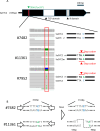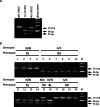Non-radiate flowers are associated with truncation of the CYCLOIDEA gene in Scaevola aemula (Goodeniaceae)
- PMID: 40696094
- PMCID: PMC12284203
- DOI: 10.1038/s41598-025-12463-z
Non-radiate flowers are associated with truncation of the CYCLOIDEA gene in Scaevola aemula (Goodeniaceae)
Abstract
Floral morphology is a crucial trait that determines the commercial value of ornamental plants and pollinator preference. Scaevola aemula (Fan Flower) typically develops bilaterally symmetrical flowers, but a recessive mutant with a radially symmetrical flower (peloric) has been isolated from a breeding population. In the present study, we explored the molecular basis of the floral traits of S. aemula. We found a genetic-phenotypic association for the CYCLOIDEA (CYC) gene SaCYC2, which is known as a regulatory gene for floral symmetry in various plants. The peloric flower line had a nonsense mutation immediately downstream of the start codon of SaCYC2 causing a loss of function. RNA-sequencing analysis revealed three paralogous CYC genes in S. aemula, but only SaCYC2 was preferentially expressed in the dorsal side of the petals. Moreover, we developed a co-dominant cleaved amplified polymorphic sequence (CAPS) marker based on the nonsense mutation to verify floral traits, thereby accelerating the selection and breeding of Scaevola spp. Our findings support the conserved function of CYC genes that determine aspects of floral morphology in Asteraceae.
Keywords: CYCLOIDEA2; Scaevola aemula; Floral symmetry.
© 2025. The Author(s).
Conflict of interest statement
Declarations. Competing interests: The authors declare no competing interests.
Figures





Similar articles
-
Pollinator-mediated selection on Krameria oil flowers: a flower-pollinator fit adaptation to an atypical oil-collecting behaviour?Ann Bot. 2024 Oct 30;134(4):603-614. doi: 10.1093/aob/mcae102. Ann Bot. 2024. PMID: 38916514 Free PMC article.
-
A single dominant GLOBOSA allele accounts for repeated origins of hose-in-hose flowers in Sinningia (Gesneriaceae).Plant Cell. 2024 Dec 23;37(1):koae283. doi: 10.1093/plcell/koae283. Plant Cell. 2024. PMID: 39422240
-
Zygomorphic flowers last longer: the evolution of floral symmetry and floral longevity.Biol Lett. 2024 Jun;20(6):20240082. doi: 10.1098/rsbl.2024.0082. Epub 2024 Jun 19. Biol Lett. 2024. PMID: 38889773 Free PMC article.
-
Signs and symptoms to determine if a patient presenting in primary care or hospital outpatient settings has COVID-19.Cochrane Database Syst Rev. 2022 May 20;5(5):CD013665. doi: 10.1002/14651858.CD013665.pub3. Cochrane Database Syst Rev. 2022. PMID: 35593186 Free PMC article.
-
Systemic pharmacological treatments for chronic plaque psoriasis: a network meta-analysis.Cochrane Database Syst Rev. 2021 Apr 19;4(4):CD011535. doi: 10.1002/14651858.CD011535.pub4. Cochrane Database Syst Rev. 2021. Update in: Cochrane Database Syst Rev. 2022 May 23;5:CD011535. doi: 10.1002/14651858.CD011535.pub5. PMID: 33871055 Free PMC article. Updated.
References
-
- Luo, D., Carpenter, R., Vincent, C., Copsey, L. & Coen, E. Origin of floral asymmetry in Antirrhinum. Nature383, 794–799 (1996). - PubMed
-
- Hsu, H. C. et al. Quantitative analysis of floral symmetry and tube dilation in an F2 cross of Sinningia speciosa. Sci. Hortic.188, 71–77 (2015).
-
- Rodger, E. W., Jones, D. L. & Blake, T. L. Encyclopaedia of Australian Plants Suitable for Cultivation 512 (Lothian Publishing, Melbourne, (1990).
-
- Seaton, K., Bettin, A. & Grüneberg, H. New ornamental plants for horticulture in. In Horticulture: Plant for People and Places (eds Dixon, G. R. & Aldous) 435–463 (Springer, 2014) (, D. E.)).
-
- Gardner, A. G. et al. Utilizing next-generation sequencing to resolve the backbone of the core Goodeniaceae and inform future taxonomic and floral form studies. Mol. Phylogenet Evol.94, 605–617 (2016a). - PubMed
MeSH terms
Substances
LinkOut - more resources
Full Text Sources
Miscellaneous

